This is Jake. His class teacher noticed that Jake performs poorly in exams. He often forgets his personal belongings, and he couldn’t sit still in classes.
But this news was a surprise for his mother because Jake was a calm kid at home. Is Jake having Attention Deficit and Hyperactivity Disorder or ADHD? To find it out, the teacher refers Jake and the mother to you, the newly appointed child psychiatrist in the tiny world of Medicine. So Doc, What do you think? Is he having ADHD?

No worries Doc! With this article, not only will you be able to answer the question, but you will also be able to diagnose ADHD, and have a pretty good idea about its management.

According to ICD 10 (International Classification of Diseases), ADHD is also known as “Hyperkinetic Disorder”. To diagnose a child with ADHD, 3 criteria must be fulfilled.
ICD 10- Criteria to Diagnose ADHD
- Attention Deficit and Hyperactivity disorder, the name itself contains two behavioral changes.
- Inattention and Hyperactivity: Therefore the first criterion is to have inattention and/or hyperactivity.
- What is inattention? Inattention is identified by observation.
- One feature of inattention is poor memory: The child will forget his or her personal belongings like the backpack, water bottle or books.
- He or she will be unable to perform tasks requiring focused attention such as drawing, writing essays, and taking exams.
- Distraction is another key feature. The child will be easily distracted by things like noises and movements.
- Alright, so how do you identify hyperactivity?
- Most children with ADHD find it difficult to sit still in a chair while watching cartoons, eating meals or taking classes.
- They get irritated quickly and might become impulsive as well.
- You can’t label a child as having ADHD just because he or she shows inattention and Hyperactivity. The ICD 10 states that these features should be observed in two different settings; both at school and the house. Let’s see why.
- A child with hearing difficulty might show poor attention during classes. But at home, he might remain seated for hours to watch cartoons. The problem for the apparent inattention in the classroom was his hearing defect and not ADHD.
- That’s why it is important to notice these differences both in school and at home.
- The third ICD criterion is that these symptoms should last for at least 6 months duration and the onset of symptoms should be at or before the age of 6.
- Why six months?
- Temporary conditions like acute medical illnesses, family problems, and other socioeconomic problems can affect a child’s behavior in the short term.
- In our case, Jake’s family moved into a new house and he didn’t like the recent change. He missed his old friends and couldn’t concentrate on schoolwork. He was calm at home because he was comfortable when he was with his family. Once he made new friends and got adjusted to the new setting, and his behavior returned to normal.
- Why six months?
- In summary: ADHD or Hyperkinetic Disorder is diagnosed when a child,
- Shows both Inattention and/or Hyperactivity/impulsiveness
- In two different settings
- With the early onset of symptoms (before the age of 6 years), that last more than 6 months.
The Aetiology of ADHD
What factors determine if someone is going to develop Attention Deficit and Hyperactivity Disorder? According to the Psychosocial Model, there are two main contributing factors for ADHD; Genes and Environment.
- Genes are the most important factor with a heritability of 76%. It’s believed to be caused by multiple genes rather than one single gene.
- Then there are environmental factors as well.
- Premature Birth, Low Birthweight and tobacco exposure during pregnancy increase the risk of ADHD as they can directly affect brain development.
- Now I want to elaborate on how socioeconomic factors can contribute to ADHD. I will explain in detail because these factors can be modified to prevent ADHD.
- A child learns from the external stimuli he or she receives from the environment. According to the stimuli, the brain builds new synapses: which is a fancy term for a connection between two neurons. And these synapses will affect the child’s behavior as he or she grows. If you are in a healthy and supportive environment the child will build good synapses.
- That’s how socioeconomic factors like poor parenting and low socio-economic class can predispose ADHD.
- Then there are environmental factors as well.
Right! Let’s move on to the management of ADHD.
Yes! We use drugs to treat ADHD! But nonpharmacological management is perhaps more important than pharmacological management. There are a few tactics we can use to help a child with ADHD.
- What can we do to help a child’s attention problem?
- The child can be seated closer to the teacher or in-between two good students.
- By seating the child in a way he or she faces the walls, rather than windows or doors, will help to reduce the distractions.
- And when you are instructing the child, use simple and short commands rather than long-chain commands.
- It is not advised to scold the child for hyperactivity or impulsiveness. You can ignore them as long as they don’t cause any harm to the child or others. But make sure to praise the child for his or her good behaviour.
Alright! Now it’s time to learn the pharmacological management.
- The Doctors will prescribe drugs from two main categories called stimulants and non-stimulants.
- Stimulants are the first line of Treatment and they work by increasing dopamine and norepinephrine levels between neuronal synapses. Methylphenidate and Dexamphetamine are two commonly used stimulants.
- Methylphenidate appears to be the drug of choice of many doctors. Though it is considered to be very safe, there are few side effects, you should be aware of.
- It can cause loss of appetite and sleep disturbances.
- It can rarely induce arrhythmias and seizures in children with pre-existing heart diseases or epilepsy.
- It may cause temporary growth faltering. But the child’s growth potential or adult stature is less likely to be affected.
- Non-Stimulants are the second line of treatment. And Most of them are antidepressants.
- Clonidine is a tricyclic antidepressant and Atomoxetine is a serotonin-norepinephrine reuptake inhibitor.
So what do you think is the correct answer to our quiz? Is Jake having ADHD or not? Let us know your answer in the comments section!
